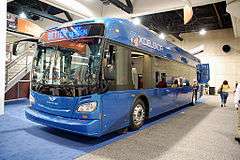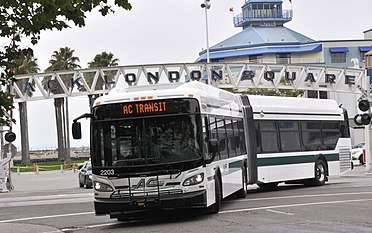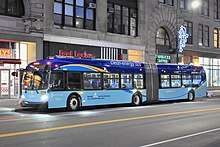New Flyer Xcelsior
The New Flyer Xcelsior is a line of transit buses available in 35' rigid, 40' rigid, and 60' articulated lengths manufactured by New Flyer Industries since 2008. In addition to the different available lengths, the buses are sold with a variety of prime movers, ranging from conventional diesel and CNG combustion engines to diesel-electric hybrid, hydrogen fuel cell, and battery electric.
| New Flyer Xcelsior | |
|---|---|
  Top: New Flyer XD40 (2008) Bottom: New Flyer XD60 (articulated, 2013) | |
| Overview | |
| Manufacturer | New Flyer |
| Production | 2008–Present |
| Body and chassis | |
| Class | Transit bus |
| Body style | Monocoque stressed-skin |
| Powertrain | |
| Engine | |
| Transmission | |
| Dimensions | |
| Wheelbase |
|
| Length | over bumpers:
|
| Width | 102 in (2.59 m) |
| Height | 10 ft 6 in (3.20 m) (diesel, over A/C) to 11 ft 1 in (3.38 m) (CNG/Electric) |
| Curb weight |
|
| Chronology | |
| Predecessor | New Flyer Low Floor |
Design
| Model | Power | Length |
|---|---|---|
| X = Xcelsior | C or N = compressed natural gas D = diesel DE = diesel-electric hybrid E = battery-electric HE = hydrogen fuel cell T = electric trolleybus |
35 = 35 feet (11 m) 40 = 40 feet (12 m) 60 = 60 feet (18 m) articulated |
For example, a New Flyer XDE40 is a 40' (nominal) rigid Xcelsior with diesel-electric hybrid power.
XE Xcelsior CHARGE
The first battery-electric Xcelsior buses were a powertrain option within the regular Xcelsior line; development was announced in 2011, a prototype was shown in 2012, and regular production began in 2014.[1] The original battery-electric Xcelsior bus, offered as an XE40, used a permanent magnet traction motor built by Siemens.[2] In October 2017, the Xcelsior CHARGE sub-line was introduced including a nice ABS and TCS for transmissions.[1]
.jpg)
The Xcelsior CHARGE variant (XEnn) uses the Siemens ELFA2 electric drive system with different options for battery capacity, depending on the charging speed and range required.[3] The traction motor used has an output of either 210 or 280 hp (160 or 210 kW) and 1,033 or 1,475 lb⋅ft (1,401 or 2,000 N⋅m).[4] Batteries are supplied by XALT Energy[5] or A123 Systems (XE60 long-range models and XHEnn fuel cell models).[4] On-route rapid charging is provided through an overhead pantograph designed to be interoperable with the SAE J3105 standard supplying 300–450 kW. Shop or depot charging may be performed using SAE J3068 and J1772 connectors supplying up to 150 kW.[4][6]
At Altoona, the as-tested empty weight of an XE40 was measured at 32,770 lb (14,860 kg) with a capacity of 76 (38 seated passengers + 37 standing passengers + 1 driver) for a total GVW of 43,550 lb (19,750 kg). It was equipped with 4 XALT Xsyst 7 (7 kWh) batteries and a SPHEROS fuel-fired heater. When accelerating from a constant speed, the bus emitted an average maximum noise level of 66.1 dB(A),[7] considerably lower than the average maximum noise level of 70.4 dB(A) measured from a conventionally-powered XD40.[8]
XE60

The articulated XE60 adds a second driven axle, using the ZF AxTrax AVE[9] on the middle axle.[1] The AxTrax AVE (formerly known as the AVE 130)[10] uses two electric motors (one per wheel), each with a maximum continuous/peak output of 160 / 340 hp (120 / 250 kW) and maximum continuous/peak torque of 6,000 / 16,200 lbf⋅ft (8,200 / 22,000 N⋅m).[11] Each motor is an asynchronous three-phase AC motor operating on 650 VDC with an input current of 250 (continuous) to 340 (peak) amps, using a single-speed reduction gear ratio of 22.66:1. The complete axle assembly weighs 2,760 lb (1,250 kg)[12]
The as-tested empty weight of an XE60 was 52,070 lb (23,620 kg) with a capacity of 120 (50 seated passengers + 69 standing passengers + 1 driver) for a total GVW of 70,170 lb (31,830 kg).[11] Compared to the diesel-powered equivalent XD60, the XE60 is heavier (XD60 GVW is 58,600 lb (26,600 kg)) and holds slightly fewer people (XD60 capacity is 123 people: 49 seated, 73 standing, 1 driver).[13] Depending on the driving route/style, the XE60 tested at Altoona had a predicted range of 145 to 246 mi (233 to 396 km).[11]
XHE fuel cell bus
The CHARGE model can be equipped with a hydrogen fuel cell (XHEnn), which acts as an on-board charger to extend range.[14] Earlier New Flyer fuel cell buses were based on the preceding Low Floor chassis, designated H40LFR, and integrated by an outside vendor. In 2016, New Flyer received an order for 25 XHE40 buses under the California Air Resources Board Air Quality Improvement Program (AQIP).[4] The XHE40 uses a MAN SE model 1350 rear axle with a traction motor from Siemens; like the XE60, the XHE60 also uses a MAN 1350 rear axle as a pusher, but adds a ZF AxTrax AVE middle axle as a puller for traction-challenged conditions.[15]
An XHE60 tested at Altoona weighed 49,890 lb (22,630 kg) empty; with a total capacity of 132 (1 driver, 50 seated, 81 standing), the estimated GVW was 69,750 lb (31,640 kg). The fuel cell was a Ballard HD85 with an 85 kW output.[15]
Deployment
The Xcelsior was introduced at the 2008 APTA Expo held in San Diego. New Flyer reduced weight by approximately 10% compared to its preceding Low Floor series, in the interest of fuel economy.[16] Brampton Transit, serving Brampton, Ontario, was the first agency to order the Xcelsior.[17]
The first trolleybus version of the Xcelsior was an XT40 built in 2014 for the Seattle trolleybus system, operated by King County Metro,[18] the first unit of an order placed in 2013.[19] King County Metro also purchased the XT60 (articulated trolleybus),[19] and both XT40s and XT60s were subsequently purchased by the San Francisco Municipal Railway, for the San Francisco trolleybus system.[20]

The first Xcelsior battery electric buses (XE40) were built in 2014 and delivered to the Chicago Transit Authority and Winnipeg Transit.[6] Massachusetts Bay Transportation Authority was the lead agency for the XE60, ordered in January 2019[21] and placed into service on July 31, 2019.[22] Development of the electric fuel cell buses is centered in California, with AC Transit serving as the lead agency for one XHE60, and SunLine Transit Agency, AC Transit, and Orange County Transportation Authority testing several variants of XHE40.[6]
Competition
References
- Plachno, Larry (April 2018). "Charging Ahead with Electric Buses" (PDF). National Bus Trader. pp. 16–25. Retrieved December 24, 2018.
- "Siemens electric Drive System to Power New Line of Transit Buses" (Press release). Siemens. October 28, 2014. Retrieved December 24, 2018.
- "Xcelsior CHARGE" (PDF). New Flyer Industries. October 2018. Retrieved December 10, 2018.
- Warren, David (November 9, 2017). "Zero-Emission Implementations" (PDF). California Transit Association. Retrieved December 24, 2018.
- New Flyer Industries (June 26, 2018). "New Flyer Xcelsior CHARGE™" (PDF). American Public Transportation Association. Retrieved December 24, 2018.
- New Flyer Industries (August 15, 2018). "New Flyer Electric Buses" (PDF). California Fuel Cell Partnership. Retrieved December 24, 2018.
- Federal Transit Bus Test: New Flyer XE40 (PDF) (Report). The Thomas D. Larson Pennsylvania Transportation Institute, The Pennsylvania State University. July 2015. Retrieved December 24, 2018.
- Federal Transit Bus Test: New Flyer XD40 (PDF) (Report). The Thomas D. Larson Pennsylvania Transportation Institute, The Pennsylvania State University. November 2012. Retrieved December 24, 2018.
- ZumMallen, Ryan (September 19, 2018). "New Flyer and ZF Building 100 Electric Buses for U.S." Trucks. Retrieved December 24, 2018.
- Thoma, Frank (December 11, 2018). "Electric mobility in size XL". Vision Magazine. ZF. Retrieved December 24, 2018.
- Federal Transit Bus Test: New Flyer XE60 (PDF) (Report). The Thomas D. Larson Pennsylvania Transportation Institute, The Pennsylvania State University. April 2019. Retrieved August 9, 2019.
- "Product Overview: Axle & Transmission Systems for Buses & Coaches" (PDF). ZF. November 2018. Retrieved December 24, 2018.
- Federal Transit Bus Test: New Flyer XD60 (PDF) (Report). The Thomas D. Larson Pennsylvania Transportation Institute, The Pennsylvania State University. July 2013. Retrieved December 24, 2018.
- "Xcelsior hydrogen fuel cell-electric bus" (PDF). New Flyer Industries. October 2017. Retrieved December 10, 2018.
- Federal Transit Bus Test: New Flyer XHE60 (PDF) (Report). The Thomas D. Larson Pennsylvania Transportation Institute, The Pennsylvania State University. August 2018. Retrieved December 24, 2018.
- Starcic, Janna; Roman, Alex; Schlosser, Nicole (November–December 2008). "Transportation's Green Future on Display at APTA EXPO" (PDF). Metro Magazine. pp. 20–50. Retrieved December 10, 2018.
- Hubbard, David (March 1, 2009). "Xcelsior gives a spirited ride". Bus Ride. Retrieved December 10, 2018.
- "Trolleynews [regular news section]". Trolleybus Magazine (318). UK: National Trolleybus Association. November–December 2014. p. 164. ISSN 0266-7452.
- "Trolleynews [regular news section]". Trolleybus Magazine (311). UK: National Trolleybus Association. September–October 2013. pp. 136–137. ISSN 0266-7452.
- "Trolleynews [regular news section]". Trolleybus Magazine (335). UK: National Trolleybus Association. September–October 2017. p. 197. ISSN 0266-7452.
- "MBTA leads Boston's evolution in transit with battery-electric buses from New Flyer" (Press release). New Flyer Industries. January 7, 2019. Retrieved August 9, 2019.
- "First Zero-emission, Battery-electric Buses Join the MBTA Silver Line Fleet" (Press release). Massachusetts Bay Transportation Authority. July 31, 2019. Retrieved August 9, 2019.
| Wikimedia Commons has media related to New Flyer Xcelsior. |
External links
- "xcelsior®" (PDF). New Flyer. September 2017. Retrieved December 10, 2018.
- "New Flyer Industries Xcelsior". Canadian Public Transit Discussion Board wiki. Retrieved December 11, 2018.